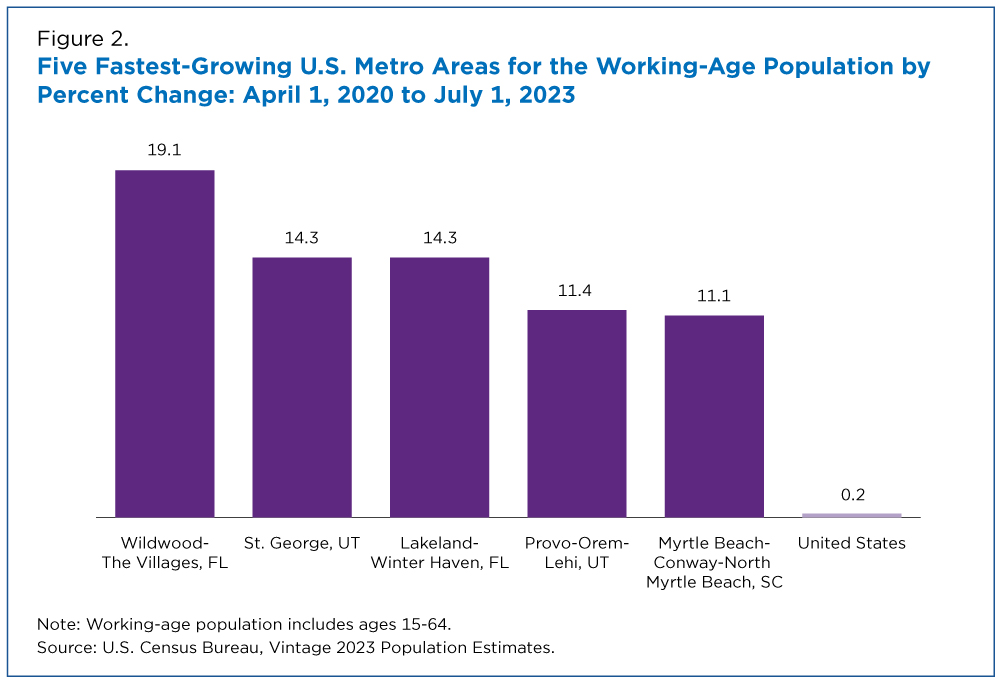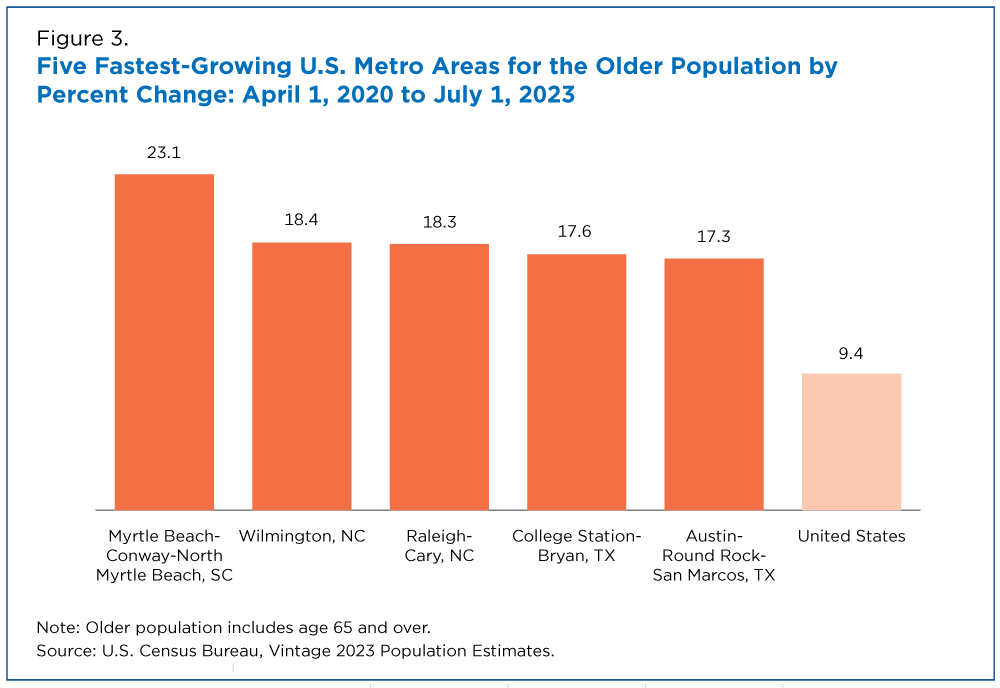While Number of People Age 65 and Older Increased in Almost All Metro Areas, Young Population Declined in Many Metro Areas From 2020 to 2023
The population age 65 and over increased in all but one (Eagle Pass, TX) of the nation’s 387 metro areas, while the population of children declined in many metro areas from April 1, 2020 to July 1, 2023.
The U.S. Census Bureau today released July 1, 2023, population estimates for U.S. metro areas by age, sex, race and Hispanic origin.
“Increased longevity and the large baby boomer generation born from 1946 to 1964 are contributing to the growth in the older adult population.”
— Lauren Bowers, chief of the
Census Bureau’s Population Estimates Branch
An examination of changes in the age make-up of the population from April 1, 2020 to July 1, 2023 revealed notable growth in the older adult population, particularly when compared to changes in the population of children.
“While some metro areas saw increases in their youth population and many saw gains in working-age populations, what's particularly remarkable is the near-universal increase in the older population for metro areas across the country,” said Lauren Bowers, chief of the Census Bureau’s Population Estimates Branch.
The three age categories featured in the analysis were: 0-14 (children); 15-64 (working age); and 65 and older (older adults).
Children: Ages 0-14
The total number of U.S. children declined by 3.3% nationally, with around 80% (311) of U.S. metro areas, including some of the most populous, experiencing a decrease in the number of children from April 1, 2020 to July 1, 2023.
New York-Newark-Jersey City, NY-NJ, Los Angeles-Long Beach-Anaheim, CA, Chicago-Naperville-Elgin, IL-IN — the nation’s three most populous metro areas in 2023 — had a combined loss of around 614,000 children since 2020, accounting for about 30% of the total U.S. decline in the number of children between 2020 and 2023.
Three California metro areas — San Jose-Sunnyvale-Santa Clara, Santa Cruz-Watsonville, and Napa — had the highest percentage losses of children: 11.8%, 11.1% and 10.7%, respectively.
The child population increased in around one-fifth of metro areas.
Lakeland-Winter Haven in Florida had the largest numeric gain in the population ages 0-14 (about 14,600) and was among five U.S. metro areas with the fastest-growing children populations. Three other Florida metro areas made the list (Wildwood-The Villages, Panama City-Panama City Beach, and Punta Gorda) and one in Georgia (Hinesville).
Working-Age Population: Ages 15-64
Between 2020 and 2023, the working-age population grew by 0.2% nationally and a majority of U.S. metro areas (about 52%) saw an increase.
Some metro areas even experienced double-digit growth in their working-age population, particularly those in the South (Florida and South Carolina) and the West (Utah).
The five metro areas with the fastest-growing working-age population were: Wildwood-The Villages, FL (19.1%); St. George, UT (14.3%); Lakeland-Winter Haven, FL (14.3%); Provo-Orem-Lehi, UT (11.4%); and Myrtle Beach-Conway-North Myrtle Beach, SC (11.1%). Punta Gorda, FL (10.3%), and Cape Coral-Fort Myers, FL (10%) also grew by at least 10% from 2020 to 2023.
These metro areas experienced growth across all three age categories.
Three Texas metro areas had six-figure gains in the working-age population during the period: Dallas-Fort Worth-Arlington (about 318,000); Houston-Pasadena-The Woodlands (about 224,000); and Austin-Round Rock-San Marcos (about 136,000).
The Dallas-Fort Worth and Houston metro areas added the most working-age residents.
The Phoenix-Mesa-Chandler, AZ, and Atlanta-Sandy Springs-Roswell, GA, metro areas also experienced notable growth in their working-age population: about 155,000 and about 124,000, respectively.
Older Adults: Age 65 and Over
The growth of the 65 and over population from 2020 to 2023 is striking: up 9.4% to approximately 59.2 million nationally. The population of older adults increased in every U.S. metro area except in Eagle Pass, TX, as previously mentioned.
Myrtle Beach-Conway-North Myrtle Beach, SC, the second-fastest growing U.S. metro area in total population between 2020 and 2023, had the fastest-growing population of older adults: up 23.1% to 107,430.
In neighboring North Carolina, both the Wilmington and Raleigh-Cary metro areas saw high growth in their older adult population this decade: up 18.4% in Wilmington and 18.3% in Raleigh.
“Increased longevity and the large baby boomer generation born from 1946 to 1964 are contributing to the growth in the older adult population,” Bowers said. “As that generation continues to age, growth in the older adult population is expected to continue across the nation’s metro areas.”
Related Statistics
Subscribe
Our email newsletter is sent out on the day we publish a story. Get an alert directly in your inbox to read, share and blog about our newest stories.
Contact our Public Information Office for media inquiries or interviews.
-
PopulationFour of Nation’s Fastest-Growing Metro Areas Are in FloridaThe Sunshine State was home to some of the fastest-growing and top-gaining metro areas, reflecting continued rapid population growth across the South.
-
PopulationWorking-Age Population Not Keeping Pace With Growth in Older AmericansPopulation estimates released by the Census Bureau today show a shift in the size of the working-age population relative to older and younger Americans.
-
Population2020 Census: 1 in 6 People in the United States Were 65 and OverThe U.S. population age 65 and over grew from 2010 to 2020 at fastest rate since 1880 to 1890 and reached 55.8 million, a 38.6% increase in just 10 years.









